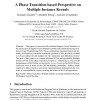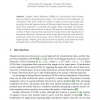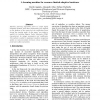104
Voted
ILP
2007
Springer
15 years 6 months ago
2007
Springer
: This paper is concerned with relational Support Vector Machines, at the intersection of Support Vector Machines (SVM) and relational learning or Inductive Logic Programming (ILP)...
111
Voted
ICCS
2007
Springer
15 years 6 months ago
2007
Springer
In this paper, active learning with support vector machines (SVMs) is applied to the problem of tornado prediction. This method is used to predict which storm-scale circulations yi...
79
Voted
ICANN
2007
Springer
15 years 6 months ago
2007
Springer
Support Vector Machines (SVMs) for classification tasks produce sparse models by maximizing the margin. Two limitations of this technique are considered in this work: firstly, th...
102
click to vote
GECCO
2007
Springer
15 years 6 months ago
2007
Springer
As a learning method support vector machine is regarded as one of the best classifiers with a strong mathematical foundation. On the other hand, evolutionary computational techniq...
ATAL
2007
Springer
15 years 6 months ago
2007
Springer
This paper addresses the problem of recognizing policies given logs of battle scenarios from multi-player games. The ability to identify individual and team policies from observat...
105
Voted
CEC
2007
IEEE
15 years 6 months ago
2007
IEEE
— Within the present paper, we put forward a novel hybridization between support vector machines and evolutionary algorithms. Evolutionary support vector machines consider the cl...
84
Voted
AHS
2007
IEEE
15 years 6 months ago
2007
IEEE
Machine Learning algorithms allow to create highly adaptable systems, since their functionality only depends on the features of the inputs and the coefficients found during the tr...
110
Voted
IJCNN
2008
IEEE
15 years 6 months ago
2008
IEEE
— Effective use of support vector machines (SVMs) in classification necessitates the appropriate choice of a kernel. Designing problem specific kernels involves the definition...
69
Voted
ICPR
2008
IEEE
15 years 6 months ago
2008
IEEE
Support Vector Machines (SVMs), though accurate, are still difficult to solve large-scale applications, due to the computational and storage requirement. To relieve this problem,...
84
Voted
ICDM
2008
IEEE
15 years 6 months ago
2008
IEEE
We present and discuss several spatiotemporal kernels designed to mine real-life and simulated data in support of drought prediction. We implement and empirically validate these k...





